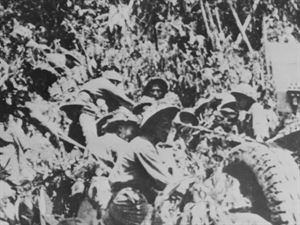ID :
324847
Wed, 04/16/2014 - 04:57
Auther :
Shortlink :
https://oananews.org//node/324847
The shortlink copeid
Dien Bien Phu- victory of sound Party leadership and resolve

HANOI, April 16 (VNA) - The Dien Bien Phu Victory (May 5, 1954) played a decisive role in ending Vietnam’s resistance war against French colonialists, ushering in the collapse of the old colonialism and marking a new development step of both Vietnam’s revolution and the struggle for peace, national independence, democracy and socialism in the world.
Researchers have agreed that the leadership of the Communist Party of Vietnam (CPV) is the decisive factor behind the victory of the Dien Bien Phu battle in particular and the resistance war against the French colonialists in general.
Following their successive defeats in the Indochinese battle field, the French colonialists drafted out the Navarre Plan with the aim of pacifying the regions under their occupation while building up a strong strategic mobile force to regain control of some areas in the Red River Delta from the revolutionary forces. Their other goal was to win a decisive battle so that they could have advantage when sitting down at the negotiation table at the Geneva Conference.
General Henri Navarre, Commander-in-Chief of the French forces in Indochina, decided to focus the defence of Vietnam’s northwestern region on the Dien Bien Phu air-infantry base and guard it at any cost.
Dien Bien Phu was a complex of strong fortresses with 16,200 French troops, the most seasoned in Indochina, stationed in 14 fortifications of three sub-divisions. After a fact-finding tour of Dien Bien Phu, US General John O’Daniel concluded that it is an unshakeable stronghold.
The CPV leadership held that only when the Dien Bien Phu fortifications are crushed will Navarre’s military scheme fall apart.
On December 6, 1953, the CPV Politburo decided to launch the Dien Bien Phu Campaign, with General Vo Nguyen Giap assigned to be the campaign’s general commander and Party leader.
To support the Dien Bien Phu campaign, the Party and President Ho Chi Minh instructed intensifying attacks on all other battlefields, particularly in the northwestern province of Lai Chau, central Laos, Lower Laos-northeastern Cambodia, northern Tay Nguyen Central Highlands and Upper Laos with the aim of straining the enemy’s forces and liberating more areas from French occupation.
The battle of wits and strength both before and during the Dien Bien Phu Campaign, with the final triumph of the Vietnamese people and revolutionary forces, proved the sound leadership of the CPV headed by President Ho Chi Minh, which is the decisive factor to create the concerted strength of the nation as a whole, thus defeating the professional soldiers of the invading French colonialists and leaving France with no other choice than to sign the Geneva Agreement on Restoring Peace in Vietnam and Indochina.
The nation mobilized all its resources for the strategic Dien Bien Phu battle. More than 260,000 labourers were called up from various regions to ensure sufficient logistics supply for the fighting soldiers. The labourers built and repaired hundreds of km of roads through mountainous terrain and transported more than 25,000 tonnes of food and thousands of tonnes of weapons to the frontline.
At the same time, the Party began implementing a policy of granting land to farmers in liberated areas. The policy helped garner the support of people in both liberated and French-occupied areas for the Party, as well as served as a great source of encouragement for soldiers fighting in the front line. This further proved that the Party’s policy of conducting a people-based and multi-faceted resistance war alongside national construction as well as the great power of the people as a whole are the key factors contributing to the victory of the Dien Bien Phu Campaign.
Meanwhile, it is the people’s army that was the direct force bringing about the success of the battle. The battle is considered the peak of Vietnam’s military art during the anti-French resistance war in terms of both strategy and tactics, particularly the fighting soldiers’ proactive spirit and creativeness. They surmounted great hardship and danger to carry heavy weapons to positions on advantageous heights, while digging a complicated system of trenches surrounding the enemy’s bases. All soldiers and units vied with each other in making firm steps forward, tightening the blockade and finally achieving victory in this historic battle.
Sixty years have passed but the lessons of the Dien Bien Phu Victory still keep their value. These lessons have been applied to the resistance war against the US for national salvation, as well as to the cause of national construction and defence in peaceful time, and have proved their usefulness not only in military but also various other domains.-VNA





